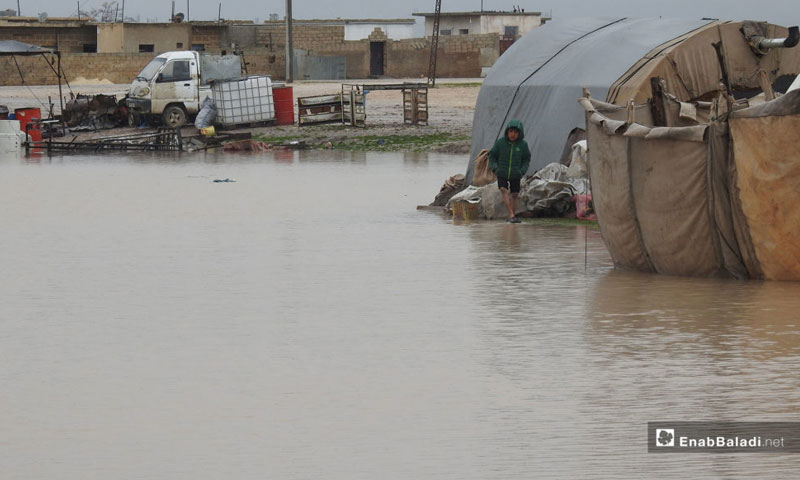Many Syrian refugees, located in the northern border with Turkey, have made repeated distress calls after rainstorms destroyed their tents, causing heavy material damages and trapping them inside mud patches after roads have been blocked.
Figures from the Response Coordinators in the north of Syria indicated that the rainstorms which hit the region at the end of last December affected more than 6,500 displaced families, while the number of tents swept by floods in Atme camps reached 220. More than 550 tents have been flooded by rain, according to Coordinators’ estimates.
Several campaigns, launched by social media activists, and the distress calls made by the local councils in the north of Syria pushed humanitarian organizations to take steps in order to contain the crisis which made camp residents suffer. Every year these refugees suffer from weather calamities during the winter and summer, amid demands to end this ongoing agony which has lasted for seven years now, as Syrian migrants’ number increased to 11 million, according to the UN figures.
Rahma Relief Foundation announced that it had built a shelter near Atme camps in the northern countryside of Idlib in order to take in families affected by the catastrophe as part of the foundation’s 2018-2019 response plan.
The head of the organization’s team in the northern Syria camps, Ali Khalaf, told Enab Baladi that the shelter is composed of temporary caravans consecrated to accommodate all the affected families previously living in Atme camps. Nonetheless, all victims are provided with daily necessities, namely, food, drinking water and heating.
He added that the response plan attempts to alleviate the financial burden on poor families harmed by rainstorms and floods in other areas, such as Khirbet al-Joz and Salqin.
The catastrophe has affected most of the camps in the north of Syria, especially Atme camp, al-Omar camp, al-Anfal camp, al-Sabirin camp and al-Weis camp, as well as Saraqeb camp, in addition to the camps based in the east of Maarat al-Numaan and other random camps. 70,000 displaced persons currently live in the aforementioned aid locations.
Violet Organization has also revealed its own response plan for damaged camps. The organization’s emergency program included the full isolation of 4,000 tents, in addition to replacing 1,000 dysfunctional tents that have been devastated by floods in the camps of the northern countryside of Aleppo.
Moreover, several institutions, media outlets and civil society organizations in Syria will organize a solidarity stand and a campaign, starting from January 13, which aim at raising awareness about the tragic circumstances that Syrian refugees face every winter in camps that lack the minimum standards to sustain human life.
Activists launched advocacy campaigns on social media platforms to support the camps’ inhabitants and make their voices heard, through the hash-tags “We all support the camp refugees” and “We are all responsible.”
The region is overwhelmed by cold weather and heavy rains, amid expectations that the northern area will go through rainstorms and snowstorms during this winter, especially in highlands.











